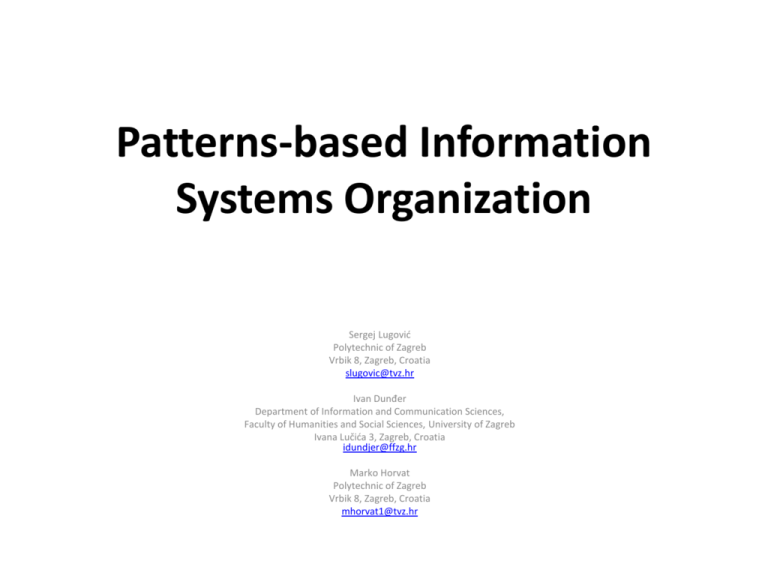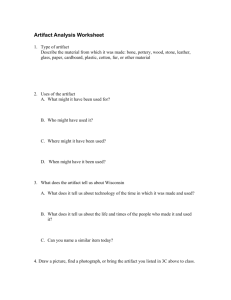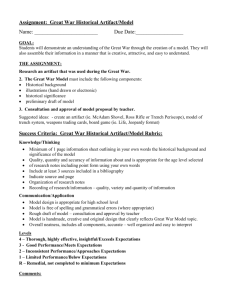Patterns-based Information Systems Organization
advertisement

Patterns-based Information Systems Organization Sergej Lugović Polytechnic of Zagreb Vrbik 8, Zagreb, Croatia slugovic@tvz.hr Ivan Dunđer Department of Information and Communication Sciences, Faculty of Humanities and Social Sciences, University of Zagreb Ivana Lučića 3, Zagreb, Croatia idundjer@ffzg.hr Marko Horvat Polytechnic of Zagreb Vrbik 8, Zagreb, Croatia mhorvat1@tvz.hr • “A pattern is a message, and may be transmitted as a message.” (Wiener, 1950) • “The transformation of noise back into signal is part of the game.” (Cohen, 2006) • “Messages can be studied according to their form, content, goal, producers, and recipients.” (Capurro, 2003) Problem Problem • portion of the digital universe holding potential analytic value is growing, but only a tiny fraction of territory has been explored. • by 2020, as much as 33% of the digital universe will contain information that might be valuable if analyzed, compared with 25% today. • value could be found in patterns in social media usage, correlations in scientific data from discrete studies, medical information intersected with sociological data, faces in security footage, and so on. • the amount of information in the digital universe that is "tagged" accounts for only about 3% of the digital universe in 2012, and that which is analyzed is half a percent of the digital universe. – THE DIGITAL UNIVERSE IN 2020: Big Data, Bigger Digital Shadows, and Biggest Growth in the Far East, December 2012, By John Gantz and David Reinsel Problems with MIS People are not included in design of MIS Hevner et al. (2004, p. 82) indirectly define IT artifact: “We include not only instantiations in our definition of the IT artifact but also the constructs, models, and methods applied in the development and use of information systems. We do not include people or elements of organizations in our definition nor do we explicitly include the process by which such artifacts evolve over time.” Hevner A.R., S.T. March, J. Park and S. Ram (2004), “Design science in information systems research”, MIS Quarterly, vol. 28, no. 1, 75-105. Model VS Technology Acceptance Davis, F. D., & Venkatesh, V. (1996). A critical assessment of potential measurement biases in the technology acceptance model: three experiments. International Journal of Human-Computer Studies, 45(1), 19-45. Going Back to Basics in Design: From the IT Artifact to the IS Artifact Lee, A. S., Thomas, M. A., & Baskerville, R. L. (2013). Going Back to Basics in Design: From the IT Artifact to the IS Artifact. Ultra Large Systems • We can collect data from system interactions, particularly patterns of people’s behavior. • As such systems decentralize, they need to have a mechanism implemented in them so they can adapt to changes. • People are not just users of the system but elements of it. • Collective behavior is of interest for system design and analysis, as behavior is a factor in how users use, view, and accept the system. • Social interactions are functions of how participants use technology and technology support their needs (Northrop at al., 2006, p.18) • In a recent massive scale experiment of Facebook users, pattern of user behavior changed according to the amount of positive or negative content in their feed. • When users were exposed to more positive content, users posted more positive status updates. • In this experiment, researchers manipulated the users’ content and measured the amount of positive or negative words in their status updates. • So by recognizing patterns of agent behavior and by intervening correlated variables, we can transmit patterns of behavior. • It’s interesting to look where user behavior comes from. • Because the agent (FB user) didn’t know about the intervention, it’s fair to say this behavior is self-organized and emerged from the internal agent behavior and not from the surrounding environment. • According to (Camazine, 2003, p.7), in self-organizing biological systems, patterns emerge from internal interactions using only information stored locally, while in systems lacking self-organization, a supervisor, directives, or already existing patterns in the environment can impose order. • Is this human(s) who changed emotional behavior selforganizing or lacking self-organization? • In our view, it’s the position of the observer observing phenomena. • If we look it from outside the system, we can recognize reference to the environment and feedback, but if we look at it from inside (from the position of the user) not knowing about intervention, then we could recognize reference to internal interactions and information stored in the user cognitive system. • In the Facebook research, we could see limitations of analyzing social agents and technology agents separately. Do we observe the social agent or tools he uses? • The research on socio-technical systems is dealing with the complexity of real situations rather than analyzing separated aspects (Ropohl, 1999). When a system is complex and dynamic, to understand the system, it’s not enough to observe its parts because knowing properties of each doesn’t give complete information about the system. • In our view, by analyzing patterns, which relate to complex behavior and dynamic interactions in a system composed of social and technical agents, we can get insight into how they emerge according to the reflection of the environment and internal properties of such a system. • So, patterns become dependent variables of the socio-technical system behavior, including internal properties and environment states. • By understanding how behavior is constructed according to the environment and internal norms stored in a system, we can comprehend the complexity of real situations. • By observing patterns, we can take a step back from the system and observer relationship, and we can observe patterns in stable processes and in the changing ones. • Different patterns will depend on steering from the outside and/or on internal system capabilities. • By applying independent and objective machine observation, we can precisely observe the dynamics of those pattern emergences. • What’s important, in our view, is that patterns can be easily described by machine quantitatively, making them different from behavior, which is qualitative and hard to recognize by machines. For the purpose of further discussion and in regard to conceptual development, we define patterns as a time sequence happening between the moment when an agent experiences information (i.e., when structured data become information) and the information-searching and seeking process starts until the moment when the agent stops interaction with the structured data as his information needs are satisfied. Such a process can occur in social and technical domains. This is a working definition describing the scope of the analysis. Information, Systems, Organization, and Patterns • we select and propose existing theoretical frameworks that support our views on patternsbased information system organization. • We combined three existing theoretical frameworks related to socio-technical systems and information, offering theoretical fundamentals for proposal of a new synthesis, one that will support the design of machines that could automatically support new behavior of the socio-technical systems. Information and patterns Deacon’s three types of information Systems and patterns Three different types of system formation (based on Hofkirchner, 1999) Organization and patterns The Tripartite Scheme (based on Kelso, 1997) Synthesis • We could clearly see that three theoretical models presented above have patterns in common. • Deacon’s model is dealing with information, the Hofkirchner’s with systems, and the Kelso’s with organization. • We could synthesize those theoretical proposals into the concept of patterns-based information systems organization. Structure level the most simple biological self-organizing system (patterns formation according to internal properties) or simple self-restructuring mechanical systems (such as a PC that self-restructures data on a hard disk) making it applicable to socio-technical system analysis. Such a system is self-restructuring when the patterns emergence forms new structures, information explained in terms of the Shannon information theory and it organized around emerging dynamic patterns, the essence of cooperation. Function level the autopoietic biological self-organizing system, which can reproduce itself, and to the intelligent mechanical system, which can reproduce its components to maintain a predefined goals execution process, making it applicable for sociotechnical system analysis. Such a system is self-reproducing in terms of functional structures; information is defined in terms of Shannon and Boltzmann entropy, which explains intentionality, “aboutness,” and reference to the information in the communication channel. And it organizes around interactions of elements for which prerequisite are formations of cooperatives. Goal level the conscious socio-technical system, which can intervene in the environment and create new goals, according to its ideas. Such a system is self-determining, when perception determines new goals, interpretation of those perceptions, and evaluation of the interpretations results in the new behavior. Information is defined in terms of evolutionary principles describing use, functions, and pragmatic consequences. And it’s organized according to the boundary conditions producing parameters acting on the system. • Therefore, if we take a point of observation from outside the system, we can see its performance, but we cannot gain insight into the emergence of particular behavior, which caused such a performance. • By observing the system from the inside, we can understand the system properties and the emergence of behavior, but we can’t see the result of such behavior. • Stepping back and observing the process of patterns formation as a dependent variable of system behavior and the system environment, we can learn how they emerge and how they relate to system performance. • And such a position of observation is objective and considers the internal system behavior and reflection to the system environment.



